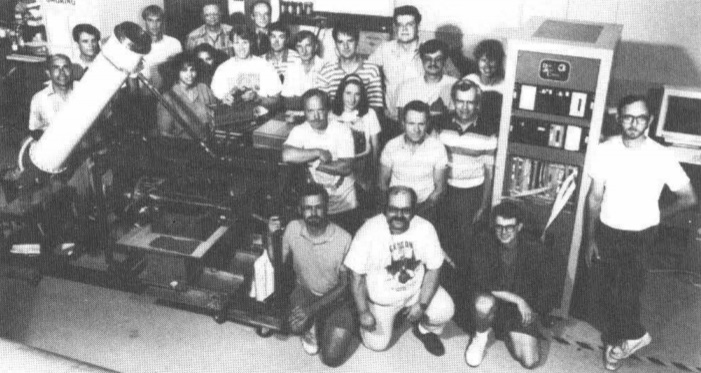Experimental Astrophysics Group Begins Initial Run

Members of the drift scan camera collaboration.
The Computing Division's Experimental Astrophysics group embarked on Fermilab's first-ever Experimental Astrophysics run August 12. The run marks the group's first use of a new charge coupled device (CCD) camera, the Drift Scan Camera. This camera is designed to take astronomical images and store them for later viewing. This CCD technology, which acts much like a piece of photographic film, now makes remote observation of the stars possible.
The purpose of this run is to test the operation of the drift scan camera that will eventually be placed on a 3.5 meter telescope at Apache Point, New Mexico, where the Sloan Digital Sky Survey telescope will be. Members of the Experimental Astrophysics group also hope to observe some interesting astronomical phenomena while conducting the nightly tests outside Lab 7.
Tim McKay, Lederman Fellow in the Physics Section and one of the key operators of the drift scan camera system, said the real virtue of doing this test run "is not looking at the sky so much as it is testing it (the camera) in something like the real mode." Tim said that through the test, which is expected to run one more week depending on the weather, the group has discovered "all kinds of things about the user interface, starting the system up, stopping it and making it run like an experiment instead as if it was in a laboratory." Tim added that the group has learned a lot about how they want to operate the camera at an observatory. "It's great to do that here instead of at a $10,000 a night telescope. Even just moving it once is a big test. But every time we do the test it gets significantly better. We have proven we can drift scan without any significant image problems."
Bryan MacKinnon of the On-line Support department said the camera is analogous to photographic film. The CCD is mounted in the dewar, or cryogenic tank. As light passes through the telescope to the CCD, image data is read from the CCD. It is monitored in real-time on a display and eventually recorded on disk and tape.
The concept of drift scanning, however, is slightly different from that of a regular video camera. "The idea of drift scanning," said Tim, "is you can point your telescope at the sky and not move the telescope. What we do in the drift scan camera is instead of rolling film, we move the image across the CCD chip at the same rate as the sky goes by. Consequently, we get a picture of a long strip of the sky."
The original idea for the camera came through the collaborative efforts of three experimental astrophysicists, Rich Kron, Steve Kent and Chris Stoughton. Since then, the project has grown to encompass four different groups at Fermilab and nearly 30 people. Besides the Experimental Astrophysics group involvement, others who played key roles in the development of the camera include the Computing Division's On-line Support department, under the guidance of Associate Head Don Petravick and the Research Division's Detector Electronic Systems group, led by the efforts of Ray Yarema and Merle Haldeman. The On-line Support group designed, developed and integrated the camera's computer system, including a custom VME board. The Detector Electronic Systems group designed and developed the front-end electronics that take the light gathered by the telescope optics and converts it to digital data. The data is then processed by the On-line Support group for various types of image reconstruction. The Physics Section, through the efforts of Hans Jostlein and others, also contributed to the project, providing the space for the telescope and camera in Lab 7 and making it possible to assemble the telescope.
The camera will be moved to Apache Point after the 3.5 meter telescope is complete. The Experimental Astrophysics group expects it to be finished in October. At Apache Point the group plans to conduct several experiments with their camera, probing such questions as the isotropy and expansion rate of the universe.


